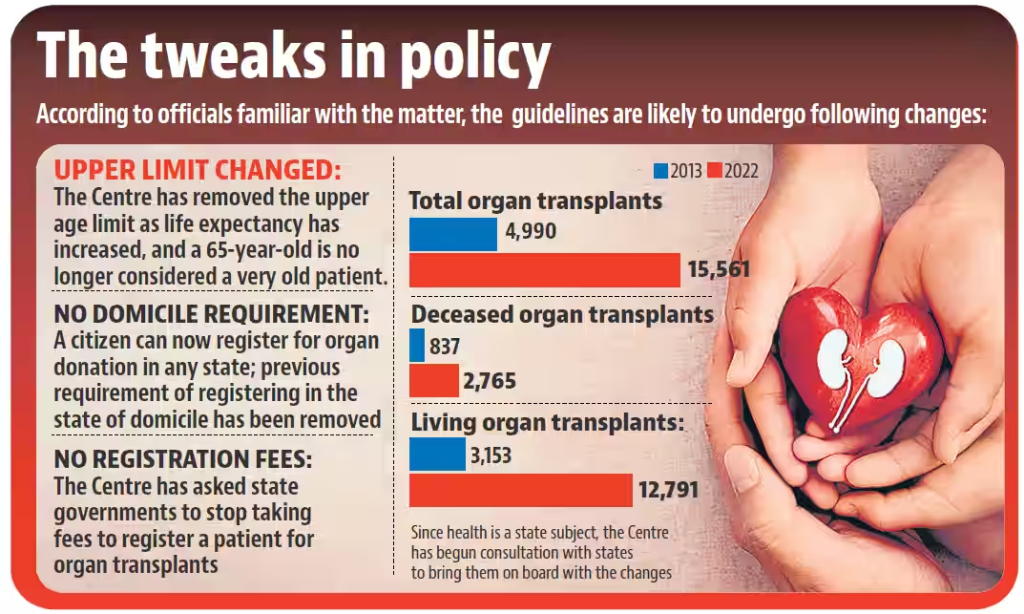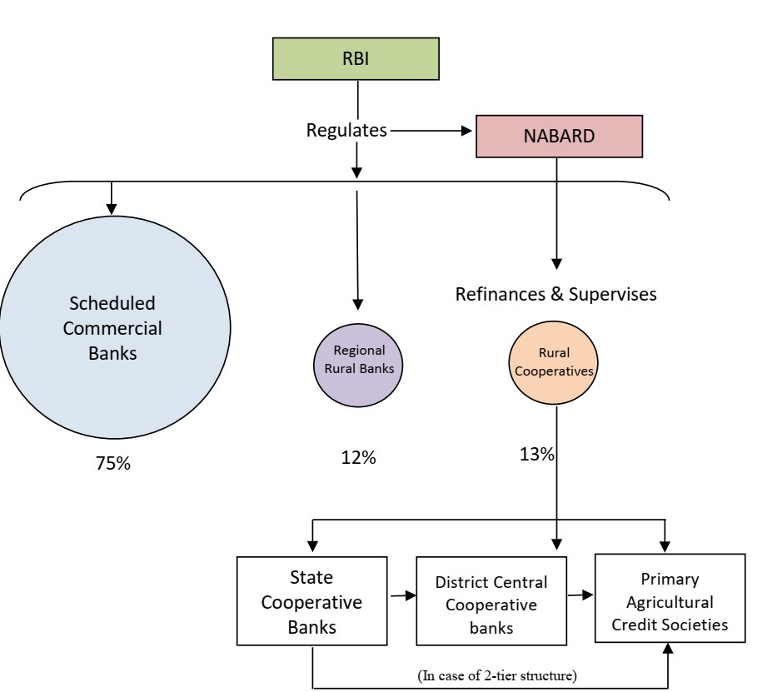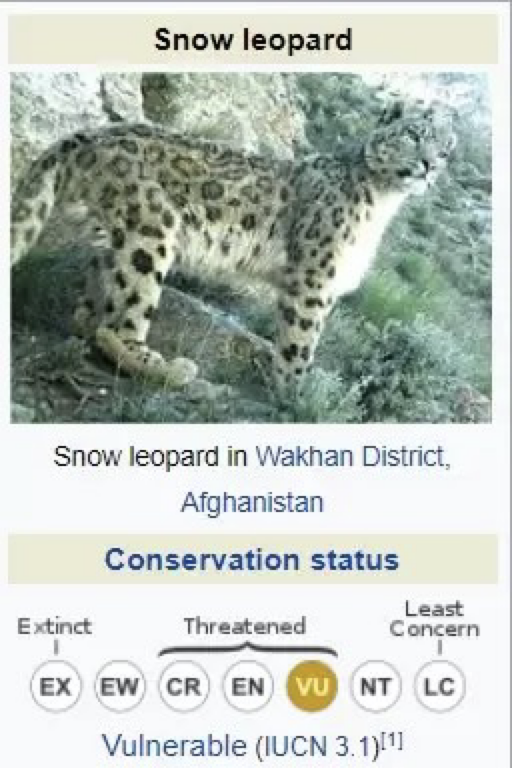CONTENTS
- National Organ Transplantation Guidelines
- Primary Agricultural Credit Societies (PACS)
- Current Account Deficit
- Snow Leopard
National Organ Transplantation Guidelines
Context:
Recently, the Ministry of Health and Family Welfare has modified National Organ Transplantation Guidelines, allowing those above 65 years of age to receive an organ for transplantation from deceased donors.

Relevance:
GS II: Polity and Governance
Dimensions of the Article:
- Transplantation of Human Organs Act, 1994
- Current situation of organ transplantation in India
- Highlights of the New Guidelines
- What is the Purpose of New Guidelines?
Transplantation of Human Organs Act, 1994
- The act provides regulations for the removal and storage of human organs.
- The act also regulates the transplantation of human organs for therapeutic purposes.
- The act aims to prevent commercial dealings in human organs.
Current situation of organ transplantation in India:
- India is the third highest country in the world for conducting transplants.
- Deceased organ donors accounted for almost 17.8% of all transplants in 2022.
- The number of deceased organ transplants increased from 837 in 2013 to 2,765 in 2022.
- The total number of organ transplants (from both living and deceased donors) increased from 4,990 in 2013 to 15,561 in 2022.
- Approximately 1.5-2 lakh people require a kidney transplant every year, but only around 10,000 received one in 2022.
- Less than 3,000 out of 80,000 people who needed a liver transplant received one in 2022.
- Only 250 out of 10,000 people who required a heart transplant received one in 2022.
Highlights of the New Guidelines
- The upper age limit for organ transplant recipients has been removed due to longer life expectancies.
- The previous NOTTO guidelines prohibited end-stage organ failure patients over 65 from receiving organs.
- The requirement for organ transplant recipients to have domicile in a particular state has been removed in a “One Nation, One Policy” initiative.
- Patients can now register for an organ transplant in any state and receive surgery there.
- There is no registration fee for organ transplant recipients, and the central government has requested that states not charge for registration.
- Several states previously charged patients between Rs 5,000 and Rs 10,000 for organ transplant recipient registration. These states include Gujarat, Telangana, Maharashtra, and Kerala.
What is the Purpose of New Guidelines?
- The Centre is planning to revise the Transplantation of Human Organs (Amendment) Act 2011 to create a national policy for transplantation.
- Currently, each state has its own rules regarding organ transplantation, and the Centre aims to establish a standard criterion that all states should follow.
- However, since healthcare is a state subject, the rules established by the central government will not be binding on the states.
- The new guidelines aim to provide better and more equitable access to organs and promote cadaver donations, which currently represent a small proportion of all organ transplants in India.
-Source: Hindustan Times
Primary Agricultural Credit Societies (PACS)
Context:
Union Cabinet recently approved the establishment of new Primary Agricultural Credit Society in 2 lakh panchayats in the next five years.
Relevance:
GS III- Indian Economy
Dimensions of the Article:
- About primary agricultural credit societies
- Objectives of PACS
- Functions of PACS
About primary agricultural credit societies:

- PACS is the smallest cooperative credit institution in India and a basic unit.
- The initial Primary Agricultural Credit Society (PACS) was founded in 1904.
- It has a grassroots effect (gram panchayat and village level).
- PACS serves as the last point of contact between the primary borrowers, or rural residents, and the higher agencies, such as the Central Cooperative Bank, State Cooperative Bank, and Reserve Bank of India.
- PACS are governed by the RBI and registered under the Co-operative Societies Act.
- The “Banking Regulation Act-1949” and the “Banking Laws (Co-operative societies) Act 1965” are in charge of them.
Objectives of PACS
- To raise capital for the purpose of making loans and supporting members’ essential activities.
- To collect deposits from members with the goal of improving their savings habit.
- To supply agricultural inputs and services to members at reasonable prices,
- To arrange for the supply and development of improved breeds of livestock for members.
- To make all necessary arrangements for improving irrigation on land owned by members.
- To encourage various income-generating activities through supply of necessary inputs and services.
Functions of PACS
- PACS typically offer the following services to their members:
- Input facilities in the form of a monetary or in-kind component
- Agriculture implements for hire
- Storage space
-Source: Indian Express
Current Account Deficit
Context:
Recently, the government released data showing that India’s exports and imports decreased by 6.59% and 3.63%, respectively, in January 2023, there are indications that the country’s current account deficit (CAD) will moderate despite the global slowdown triggered by the rising inflation and interest rates.
Relevance:
GS III- Indian Economy (Growth and Development)
Dimensions of the Article:
- What is the Current Account Deficit?
- What is Balance of Payments?
- What are the reasons for the current account deficit?
What is the Current Account Deficit?
- A current account deficit occurs when the total value of goods and services a country imports exceeds the total value of goods and services it exports.
- The balance of exports and imports of goods is referred to as the trade balance. Trade Balance is a part of ‘Current Account Balance’.
- According to an earlier report of 2021, High Oil Imports, High Gold Imports are the major driving force, widening the CAD.
What is Balance of Payments?
- BoP of a country can be defined as a systematic statement of all economic transactions of a country with the rest of the world during a specific period, usually one year.
- Purposes of Calculation of BoP:
- Provides information about a country’s financial and economic situation.
- Can be used to evaluate whether the value of a country’s currency is appreciating or depreciating.
- Assists the government in making budgetary and trade policy decisions.
- Provides crucial data for analysing and comprehending the economic dealings of a country with other countries.
Components of the Balance of payments (BOP)
- Current account: It includes the financial transactions dealing with the export and import of goods, services, unilateral transfers, investment income etc.
- Capital account: It includes the financial transactions dealing with assets such as foreign direct investment, foreign portfolio investment, foreign loans etc.
- Official reserve transactions: It conducted by the central bank in case of the BOP deficit or BOP surplus.
- Errors and omissions: It is the element of BOP (other than the current account and the capital account) which refers to the balancing items reflecting the inability to record all the international financial transactions.
What are the reasons for the current account deficit?
- Intensifying geopolitical tensions and supply chain disruptions leading to crude oil and commodity prices soaring globally have been exerting upward pressure on the import bill.
- A rise in prices of coal, natural gas, fertilizers, and edible oils have added to the pressure on trade deficit.
- However, with global demand picking up, merchandise exports have also been rising.
-Source: The Hindu
Snow Leopard
Context:
A snow leopard has been sighted for the first time at a height of about 11,120 feet in the Darma valley in Uttarakhand’s Pithoragarh district.
Relevance:
GS III- Environment and Ecology
Dimensions of the Article:
- About the Snow leopard
- Snow Leopards in India and their conservation
About the Snow leopard

- The snow leopard is a large cat native to the mountain ranges of Central and South Asia.
- It is listed as Vulnerable on the IUCN Red List.
- The snow leopard, like all big cats, is listed on Appendix I of the Convention on International Trade of Endangered Species (CITES), which makes trading of animal body parts (i.e., fur, bones and meat) illegal in CITES signatory countries.
- Global population is estimated to number less than 10,000 mature Snow Leopards.
- It inhabits alpine and subalpine zones at elevations from 3,000 to 4,500 m.
- It is threatened by poaching and habitat destruction following infrastructural developments.
Snow Leopards in India and their conservation
- In India, their geographical range encompasses a large part of the western Himalayas including the states of Jammu and Kashmir, Himachal Pradesh, Uttarakhand and Sikkim and Arunachal Pradesh in the eastern Himalayas. The last three states form part of the Eastern Himalayas – a priority global region of WWF and the Living Himalayas Network Initiative.
- Project Snow Leopard (PSL): It promotes an inclusive and participatory approach to conservation that fully involves local communities.
- SECURE Himalaya: Global Environment Facility (GEF)-United Nations Development Programme (UNDP) funded the project on conservation of high-altitude biodiversity and reducing the dependency of local communities on the natural ecosystem. This project is now operational in four snow leopard range states, namely, Jammu and Kashmir, Himachal Pradesh, Uttarakhand, and Sikkim.
-Source: The Hindu





